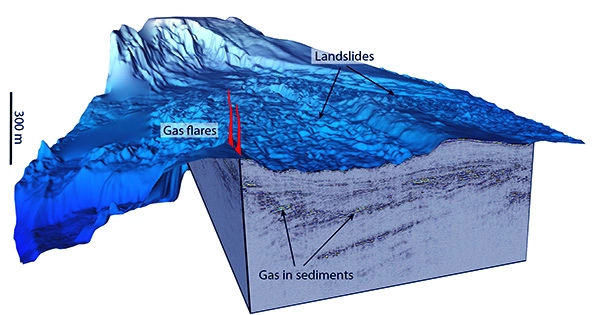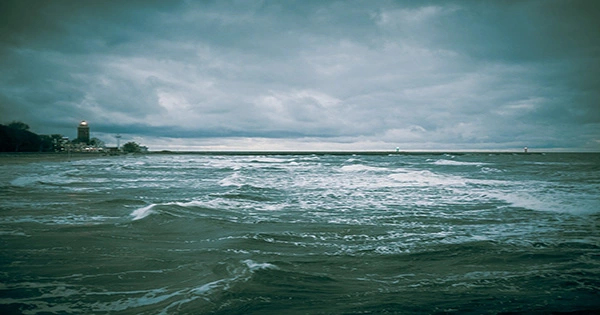Researchers from Linnaeus University and Stockholm University have discovered an area with large emissions of the potent greenhouse gas methane from the bottom sediments during a study voyage to the deepest portions of the Baltic Sea in the Landsort Deep.
The methane leak was discovered in the Landsort Deep (Landsortsdjupet), approximately 30 kilometers southeast of the coastal town of Nynäshamn. The discovery has astonished Christian Stranne, associate professor of marine geophysics at Stockholm University.
“We know that methane gas can bubble out from shallow coastal seabeds in the Baltic Sea, but I have never seen such an intense bubble release before and definitely not from such a deep area,” adds Stranne.

A poorly understood phenomenon: The project’s goal is to learn more about methane and its sources and sinks in the oxygen-free habitats of the Baltic Sea’s deep waters. Marcelo Ketzer, a professor of environmental science at Linnaeus University, is in charge of the project.
“Knowledge about the factors that influence how much methane is produced in these deeper areas and where it goes is limited.” How does the system respond to changes such as eutrophication or a warmer climate? “I knew from one of my previous projects that the methane levels in these sediments were higher than elsewhere in the Baltic Sea, but I never expected methane to bubble out into the sea in this way,” Marcelo Ketzer says.
The researchers concluded that the area is around 20 square kilometers in size (equal to nearly 4,000 football fields) and resides at a depth of approximately 400 meters. A vast number of sediment cores and water samples were gathered during the voyage, and the researchers now expect that future analysis will be able to provide answers as to why so much methane gas is emitted from this specific place.
“We already have a good idea why it looks the way it does.” The size of the sediment grains in the area and the shape of the bottom provide clues. “It appears that deep ocean currents are causing sediment accumulation in this area, but we need to do more detailed analyses before we can say anything definitive,” Marcelo Ketzer adds.
The bubbles rise to the surface of the sea: Another intriguing discovery revealed during the expedition involves the height to which methane bubbles climb in the water column.
“At the depths we’re working with here, methane bubbles should reach no more than 150-200 meters from the seabed.” “Because the methane in the bubbles dissolves in the ocean, they usually gradually shrink in size as they rise to the sea surface,” says Christian Stranne.
“It is actually quite a complicated balance between pressure effects and diffusion of gases that together determine how size and gas composition develop in a bubble, but the net effect for smaller bubbles is that they lose both size and rise velocity with increased distance from the bottom.”
The researchers were astounded to witness bubbles rising up to 370 meters from the ocean floor.
“Bubbles from deep-sea sediments (around a thousand meters and deeper) can rise significantly higher due to a coating of ‘frozen methane’ that forms around the bubble,” Stranne explains.
“This summer, I joined a French expedition to the Amazon outlet, where we saw bubbles rising 700 meters above the seabed.” But I’m not aware of any study that has detected such persistent bubbles at these depths—it could be a new world record, and it could compel us to reconsider the role of deep basins in the Baltic Sea in terms of contribution to surface water methane levels.”
Oxygen-free bottoms mighty be the explanation: So far, the researchers have been unable to determine the exact height of the bubbles. They can observe bubbles up to 40 meters from the sea surface using sonar, but it’s possible that some bubbles reach far higher. One explanation could be because the bubbles are abnormally enormous, but the researchers believe that another explanation is more likely.
“Rather, we believe it is related to the oxygen-free conditions in the Baltic Sea’s deep water.” When there is little oxygen, the amounts of dissolved methane in the water might be relatively high, causing the bubbles to lose methane more slowly. “Because the bubbles are kept more intact in this environment, methane transport to the sea surface becomes more efficient,” adds Stranne.
“It is a hypothesis that we are currently investigating and if it proves to be correct, it could have consequences—if the oxygen conditions in the Baltic Sea deteriorate further, it would probably lead to a greater transport of methane from the deeper parts of the Baltic Sea, but it remains to be investigated how much may leak into the atmosphere.”
Marcelo Ketzer and Christian Stranne believe that methane gas emissions similar to those seen in the Landsort Deep could occur elsewhere in the Baltic Sea.
“Now we know what to look for, and we’re excited to put this model to the test in other parts of the Baltic Sea with similar geological conditions.” There could be another half-dozen sites to visit” Marcelo Ketzer adds.
















